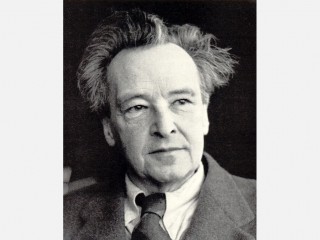
Arthur Honegger biography
Date of birth : 1892-03-10
Date of death : 1955-11-27
Birthplace : Le Havre, France
Nationality : Swiss
Category : Famous Figures
Last modified : 2010-12-13
Credited as : Composer, ,
Although Arthur Honegger (1892-1955) was a Swiss composer, he was identified with France because of his long residence in Paris. He was a middle-of-the-road 20th-century composer; as a result, some of his compositions were immediately popular.
Arthur Honegger was born in Le Havre, France, where his Swiss father was a coffee importer. The family was cultured and encouraged their son's interest in music by giving him violin and harmony lessons, studies that were continued at the Zurich Conservatory (1909-1911). In 1911 he commuted once a week from Le Havre to Paris to study violin at the conservatory and in 1913 became a full-time student.
This was an exciting time for a young musician to be in Paris, and Honegger plunged into the musical stream, attending the ballet and opera and becoming acquainted with the new works of Claude Debussy, Maurice Ravel, and Igor Stravinsky. Because of his study in Switzerland, his musical orientation had been German; Richard Wagner, Richard Strauss, and Max Reger had been his models, and he never really abandoned them even when he became influenced by the newer French music. Darius Milhaud was his classmate at the conservatory and introduced him to a group of young composers; in 1920 they gave a joint concert of their works. The critic who reviewed the concert entitled his article "The Russian Five and the French Six, " referring to the great school of Russian nationalistic composers and to Honegger and his friends—Milhaud, Francis Poulenc, Germaine Tailleferre, Louis Durey, and Georges Auric. The label stuck, and for the rest of their lives these composers never lived down the association, no matter how divergent their mature styles became. The term "Les Six" connoted an attitude that was antiromantic and which held that music should not take itself too seriously. "Down with Wagner. Down with Beethoven, " they said. "Let's have music that is clever and gay, as simple as the music of the street."
Honegger never shared these views. On the contrary, he said: "My great model is J. S. Bach. I do not seek, as do some anti-impressionist composers, a return to harmonic simplicity. I find, on the contrary, that we should use the harmonic materials created by the school that preceded us, but in a different way, as the base for lines and rhythms. Bach availed himself of the elements of tonal harmony, as I want to avail myself of modern harmony. I am not a party to the cult of the Music Hall and the Street Fair, but on the contrary I am dedicated to chamber music and symphonic music in their most serious and austere aspects."
Honegger was fascinated by sports and machinery. Two of his early compositions, Pacific 231 (1923), a vivid description of a powerful locomotive starting, accelerating, and stopping, and Rugby (1928), a description of a football game, were instantly popular. Another early work that brought him recognition was his oratorio King David (1923), a large-scale work for chorus, soloists, orchestra, and a narrator, who provides continuity between the musical numbers. Based on the biblical story of David, Honegger's score includes pseudo-Oriental orchestral pieces and Bach-style choruses, along with dissonant harmonies. The total effect is rich and brilliant. Other large-scale choral works include Jeanne d'Arc aux bûcher (1938; Joan of Arc at the Stake), which is sometimes staged in operatic manner, and The Dance of Death (1940). Antigone (1927) is an austere one-act opera. He also wrote chamber music and five symphonies, the fifth commissioned and first performed by the Boston Symphony in 1952.
Honegger stated his creed as a composer: "My desire and my endeavor have always been to write music which would be attractive to the large masses of listeners and which would, at the same time, be sufficiently devoid of banalities to interest music lovers." Certain of his compositions succeed in achieving this balance, and Honegger was one of the most successful composers of his generation.
There is no book-length study of Honegger in English, but a series of interviews with him has been translated as I Am a Composer (1966). Honegger is considered in these discussions of contemporary music: David Ewen, ed., The New Book of Modern Composers (1943; 3d rev. ed. 1964), and Ewen's own work, The World of Twentieth-Century Music (1968); Howard Hartog, ed., European Music in the Twentieth Century (1957); Peter S. Hansen, An Introduction to Twentieth Century Music (1961); Joseph Machils, Introduction to Contemporary Music (1961); and A. L. Bacharach, ed., The Music Masters, vol. 4 (1970).
















